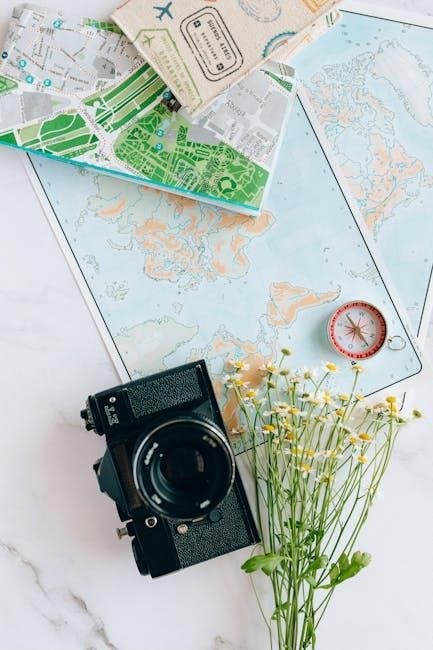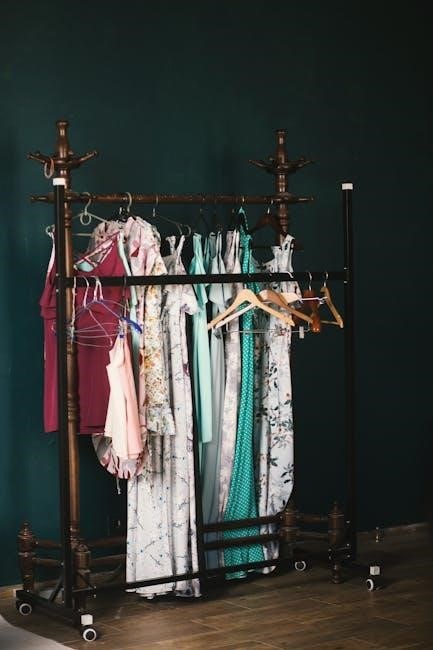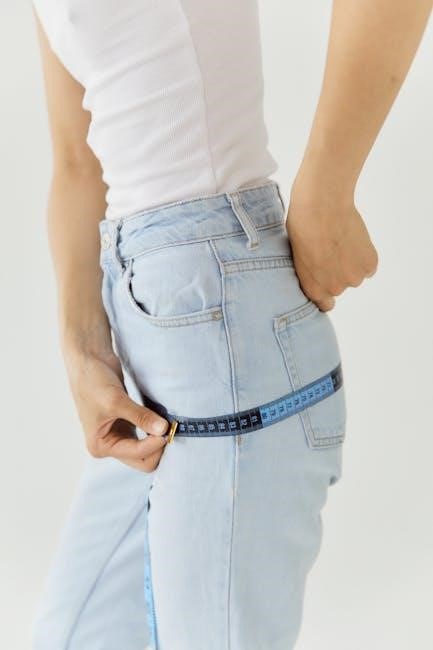
Welcome to the comprehensive guide for women’s clothing sizes‚ designed to help you find the perfect fit across various brands and styles․ This guide addresses the challenges of varying sizes‚ ensuring confidence and comfort in your wardrobe choices․ Whether shopping online or in-store‚ this detailed resource covers everything from standard measurements to international conversions‚ making it your ultimate tool for flawless fits․
Importance of Accurate Sizing
Accurate sizing is crucial for ensuring a perfect fit‚ boosting confidence‚ and enhancing overall comfort․ Incorrect sizes can lead to discomfort‚ poor aesthetics‚ and the hassle of returns or alterations․ With varying standards across brands and regions‚ precise measurements are key to avoiding these issues․ Proper sizing ensures garments drape well‚ allowing for freedom of movement and a flattering appearance․ It also reduces the likelihood of purchasing mistakes‚ saving time and effort․ By understanding and using accurate size charts‚ shoppers can enjoy a seamless wardrobe experience‚ whether buying online or in-store․ This guide provides detailed insights to help you make informed choices and find your ideal fit effortlessly․
Understanding Size Variability
Size variability in women’s clothing is a common challenge due to differences in brand standards and international sizing systems․ Unlike men’s clothing‚ which follows more standardized measurements‚ women’s sizes can vary significantly between brands and regions․ This inconsistency arises from factors like vanity sizing‚ where sizes are adjusted to flatter customers‚ and regional fit preferences‚ such as tighter cuts in European brands versus looser fits in American ones․ Additionally‚ some brands cater to specific body types‚ further diversifying size interpretations․ Understanding these variations is essential for navigating size charts effectively and ensuring the best fit regardless of the brand or region․ This guide helps clarify these differences‚ empowering shoppers to make informed decisions․

Standard Women’s Clothing Size Charts
Standard women’s size charts provide a reference for determining clothing fit based on body measurements․ They typically include bust‚ waist‚ and hip measurements in inches or centimeters‚ varying by region․
US Size Chart Details
The US women’s size chart provides standardized measurements for clothing‚ helping consumers determine their fit․ Sizes typically range from XS (0-2) to 3X (50-53)‚ with corresponding bust‚ waist‚ and hip measurements․ For example‚ a size XS corresponds to a bust of 31․5-32․5 inches‚ while a size L (12-14) corresponds to a bust of 38-39 inches․ These measurements are crucial for ensuring the best fit․ If measurements fall between two sizes‚ it is often recommended to choose the larger size for comfort․ Detailed charts are available for specific categories like dresses‚ tops‚ and bottoms‚ making it easier to find the perfect fit across various clothing types․ This guide is essential for both online and in-store shopping experiences․
UK Size Chart Details
The UK women’s size chart offers a structured approach to finding the right fit‚ with sizes ranging from 4 to 18․ Each size corresponds to specific body measurements‚ ensuring accuracy and comfort․ For instance‚ a UK size 10 typically corresponds to a bust of 34-35 inches‚ a waist of 27-28 inches‚ and hips of 36-37 inches; These measurements are consistent across most UK brands‚ though variations may occur․ The chart also includes dual sizing‚ often displayed as a single size alongside UK and EU equivalents‚ making it easier for international shoppers to find their match․ This guide is particularly useful for those shopping from UK-based retailers like ASOS‚ ensuring a seamless and confident purchasing experience․
EU Size Chart Details
The EU women’s size chart provides a clear and standardized system for determining clothing sizes across European countries․ Sizes typically range from 34 to 46‚ corresponding to specific body measurements in centimeters․ For example‚ a size 38 generally fits a bust of 88-92 cm‚ a waist of 68-72 cm‚ and hips of 94-98 cm․ This numerical system offers consistency‚ making it easier for shoppers to identify their size․ EU sizes often align with UK sizes but differ from US measurements‚ requiring conversion for international shoppers․ The chart is widely used by European brands‚ ensuring a reliable fit․ Dual sizing charts‚ which include both EU and UK/US equivalents‚ are commonly provided to facilitate seamless shopping experiences across borders․ This system is particularly popular among global retailers catering to diverse markets;

International Size Conversions
Understanding global size differences is crucial for seamless shopping․ This section helps convert women’s clothing sizes across regions‚ ensuring a perfect fit whether you’re in the US‚ EU‚ or UK․
Converting US to UK Sizes
Converting US to UK sizes involves understanding the numerical differences between the two systems․ US sizes typically start at 0-2 for the smallest sizes‚ while UK sizes begin at 4-6․ For example‚ a US size 8 corresponds to a UK size 12‚ and a US size 10 aligns with a UK size 14․ This conversion pattern continues‚ with each US size increment translating to a UK size that is roughly 4-6 numbers higher․ To ensure accuracy‚ refer to specific charts that outline exact measurements for bust‚ waist‚ and hips‚ as these can vary slightly between brands․ Proper conversion helps in selecting the correct fit when shopping internationally or online․
Converting US to EU Sizes
Converting US to EU sizes requires understanding the numerical differences between the two systems․ US sizes start lower‚ while EU sizes are typically offset by 30-32․ For example‚ a US size 8 corresponds to an EU size 36‚ and a US size 10 aligns with an EU size 38․ These conversions are based on standard body measurements‚ with EU sizes often reflecting actual centimeter measurements․ However‚ variations exist between brands due to different sizing standards and vanity sizing․ To ensure accuracy‚ refer to specific size charts that map US to EU sizes‚ especially for categories like dresses‚ tops‚ and bottoms․ Always consider brand-specific guides for the best fit when shopping internationally or online․
Global Size Comparison Chart
A global size comparison chart is essential for understanding how women’s clothing sizes vary across regions․ This chart aligns US‚ UK‚ EU‚ and other international sizes‚ providing a clear reference for shoppers․ For instance‚ a US size 8 typically corresponds to a UK size 12 and an EU size 36․ However‚ variations occur due to different measurement standards and brand practices․ The chart covers categories like dresses‚ tops‚ and bottoms‚ ensuring accurate conversions․ It’s a valuable tool for international shopping‚ helping consumers choose the right fit regardless of the country or brand․ By referencing this chart‚ shoppers can navigate size differences confidently‚ making online purchases more straightforward and reliable․

How to Measure Yourself Accurately
Use a flexible tape measure to take precise body measurements․ Stand upright‚ breathe naturally‚ and measure around the bust‚ waist‚ and hips for accurate size determination․ Ensure the tape is snug but not tight for the best fit results․
Measuring the Bust
Measuring the bust accurately is crucial for determining your clothing size․ To do this‚ wrap a flexible tape measure around the fullest part of your chest‚ keeping it level and parallel to the floor․ Ensure the tape isn’t too tight or too loose—ideally‚ you should be able to fit one finger comfortably underneath․ The measurement should encompass the entire bust‚ including the nipple area‚ but should not dip below the underbust․ For the most accurate result‚ exhale slightly and relax your shoulders․ This measurement is essential for sizing tops‚ dresses‚ and bras․ Always refer to the specific size chart for the brand you’re shopping with‚ as sizing can vary slightly between brands and regions․
Measuring the Waist
Measuring your natural waistline is essential for determining your accurate clothing size․ To find your waist measurement‚ locate the narrowest point of your torso‚ typically just above your navel and below your ribcage․ Wrap a flexible tape measure around this area‚ ensuring it remains level and parallel to the floor․ Keep the tape measure snug but not overly tight—you should be able to slip one finger underneath comfortably․ Take a deep breath and relax your muscles to get an accurate reading․ This measurement is critical for sizing bottoms‚ dresses‚ and outerwear․ Remember‚ sizes can vary between brands‚ so always consult the specific size chart for the best fit․
Measuring the Hips
To accurately measure your hips‚ stand up straight and locate the widest part of your hips‚ typically 7-9 inches (18-23 cm) below your natural waistline․ Wrap a flexible tape measure around this area‚ ensuring it remains level and parallel to the floor․ The tape should fit snugly but not tightly‚ allowing for a full range of motion․ This measurement is crucial for determining the fit of dresses‚ skirts‚ and pants․ For the most accurate results‚ measure over the thinnest part of your clothing or directly on your skin․ Keep your arms relaxed at your sides to avoid altering the measurement․ This step ensures a precise fit‚ especially for garments that accentuate the hip area‚ such as fitted dresses or trousers․

Why Clothing Sizes Vary
Clothing sizes differ due to brand-specific standards‚ international sizing variations‚ and vanity sizing․ These factors create inconsistency‚ making it essential to refer to size charts for accurate fits․
Brand-Specific Standards
Brand-specific standards significantly influence women’s clothing sizes‚ leading to variability across labels․ Each brand tailors its sizing to fit its target audience‚ resulting in inconsistent measurements․ For instance‚ a size 8 at one retailer may equate to a size 6 or 10 elsewhere․ This disparity stems from differing fit preferences‚ fabric types‚ and design aesthetics․ Some brands adopt a “vanity sizing” approach‚ where sizes are adjusted to make customers feel slimmer‚ further complicating the landscape․ Understandably‚ this can confuse shoppers‚ especially when buying from multiple brands․ To navigate this‚ it’s crucial to consult each brand’s specific size chart to ensure the best fit․
International Sizing Differences
International sizing differences in women’s clothing can be perplexing due to varying standards across regions․ For example‚ a US size 8 may correspond to a UK size 12 or an EU size 38‚ highlighting the lack of global uniformity․ These discrepancies arise from different measurement systems and cultural perceptions of fit․ European sizes often emphasize a more tailored look‚ while US sizes may offer a relaxed fit․ Additionally‚ countries like Japan and Australia have their own unique sizing scales‚ further complicating the matter․ To avoid confusion‚ shoppers should refer to international conversion charts and brand-specific guides‚ ensuring they select the correct size for their region and desired fit․

Category-Specific Size Guides
Explore tailored sizing advice for dresses‚ tops‚ bottoms‚ outerwear‚ swimwear‚ underwear‚ and accessories‚ ensuring a perfect fit for every wardrobe essential and personal style preference․
Dresses and Skirts
Dresses and skirts require precise sizing to ensure a flattering fit․ Measure your bust‚ waist‚ and hips to determine your size․ Consider your body shape—hourglass‚ pear‚ or rectangular—and choose styles that complement it․ For dresses‚ check the length to ensure it flatters your proportions․ Skirts should sit at your natural waistline for the most flattering fit․ Pay attention to fabric type‚ as stretchy materials may fit differently than structured ones․ If between sizes‚ opt for the larger one for comfort․ Use online size charts‚ like ASOS or Calvin Klein‚ to compare measurements․ Ensure ease of movement and avoid tight fits for a comfortable‚ stylish look․ Proper fit enhances both appearance and confidence․ Always refer to brand-specific guides‚ as sizing can vary slightly between labels․
Tops and Blouses
When selecting tops and blouses‚ accurate measurements are crucial for a flattering fit․ Measure your bust‚ waist‚ and hips to align with size charts․ Consider the style—fitted‚ loose‚ or tunic—to ensure comfort and flattery․ For example‚ a tailored blouse may require precise bust measurements‚ while a flowy top offers more flexibility․ Check brand-specific guides‚ as sizes can vary․ If your measurements fall between sizes‚ opt for the larger one․ Pay attention to fabric stretch and length to ensure the garment sits correctly on your body․ Use resources like ASOS or Calvin Klein size charts for reference․ Proper fit enhances both style and comfort‚ making it essential to choose wisely based on your measurements and personal preferences․ This ensures a polished‚ confident look in any top or blouse․
Bottoms and Pants
Finding the perfect fit for bottoms and pants involves measuring your waist‚ hips‚ and inseam․ Use these measurements to align with size charts‚ ensuring comfort and style․ Consider the style—skinny‚ straight‚ or wide-leg—as each fits differently․ For example‚ skinny jeans may require precise hip measurements‚ while wide-leg pants offer more flexibility․ Check fabric stretch‚ as stretchy materials allow for a snug fit without sizing up․ If your measurements fall between sizes‚ opt for the larger one․ Pay attention to rise height (low‚ mid‚ or high) for personal comfort․ Use brand-specific guides‚ like ASOS or Calvin Klein charts‚ for accurate sizing․ Proper fit enhances both style and comfort‚ making it essential to choose wisely based on your measurements and personal preferences․ This ensures a polished‚ confident look in any bottoms or pants․
Outerwear and Jackets
Outerwear and jackets require careful sizing to ensure both style and functionality․ Measure your chest‚ shoulders‚ and length to match size charts․ Consider the fit—whether oversized‚ fitted‚ or tailored․ For example‚ a parka may need a looser fit for layering‚ while a blazer should skim your body․ Check the shoulder fit‚ as ill-fitting shoulders can ruin the look․ Use brand-specific guides‚ as sizing varies․ Fabric type matters too; bulky materials may require a larger size for comfort․ Ensure the jacket’s length aligns with your torso for a balanced look․ Don’t forget to account for any layers you’ll wear underneath․ Proper fit ensures both comfort and a polished appearance‚ making outerwear a versatile and essential part of your wardrobe․ Always refer to the brand’s size chart for accurate measurements and the best fit․
Swimwear
Swimwear sizing varies by style and brand‚ making accurate measurements crucial for the best fit․ Measure your bust‚ waist‚ and hips to align with size charts․ Bikinis‚ one-pieces‚ and tankinis fit differently‚ so consider your body type and preferred coverage․ A well-fitting swimsuit should provide comfort and support without digging or gapping․ If you’re between sizes‚ opt for the larger one for a more relaxed fit․ Fabric type and stretch also impact how the suit will feel․ Use brand-specific guides‚ as sizing can differ significantly․ Pay attention to cup sizes for swimsuits with built-in bras․ Don’t hesitate to try multiple sizes if unsure‚ as swimwear sizing is less standardized than other apparel․ A proper fit ensures confidence and comfort‚ whether at the beach or pool․
Underwear and Lingerie
Underwear and lingerie sizing requires precise measurements for comfort and support․ Measure your wrist and hip to determine your size accurately․ Different styles like bras‚ panties‚ and shapewear have specific fits‚ so use brand-specific charts․ Variations exist‚ so try multiple sizes if unsure․ Fabric and elasticity affect fit‚ so choose materials suitable for your needs․ Proper fit ensures all-day comfort and confidence‚ whether for daily wear or special occasions․
Accessories
Accessories like hats‚ scarves‚ and belts often have standardized sizing․ Use your body measurements to ensure the best fit․ For hats‚ measure your head circumference; for scarves‚ length is typically uniform․ Belts are sized by waist measurement‚ so choose based on your natural waistline․ Gloves require precise hand measurements to ensure comfort and dexterity․ While accessories may not vary as much as clothing‚ checking size charts ensures a perfect fit․ Properly fitting accessories enhance your overall look and comfort‚ making them essential additions to your wardrobe․ Always refer to brand-specific guides for accurate sizing․

Plus-Size Clothing Guide
Discover the perfect fit with our plus-size clothing guide‚ offering detailed size charts and styling tips for curves․ Explore sizes 18 to 36 and beyond‚ ensuring comfort and confidence․
Plus-Size Sizing Chart
Our plus-size sizing chart provides a comprehensive guide to finding your perfect fit․ Sizes range from 18 to 36‚ with detailed measurements for bust‚ waist‚ and hips․ For instance‚ size 18 corresponds to a bust of 46-49 inches‚ waist 38-42 inches‚ and hips 50-54 inches․ Size 20 fits a bust of 48-51 inches‚ waist 40-44 inches‚ and hips 52-56 inches․ Size 22 accommodates a bust of 50-53 inches‚ waist 42-46 inches‚ and hips 54-58 inches․ Size 24 offers a bust of 52-55 inches‚ waist 44-48 inches‚ and hips 56-60 inches․ Size 26 fits a bust of 54-57 inches‚ waist 46-50 inches‚ and hips 58-62 inches․ Finally‚ size 28 corresponds to a bust of 56-59 inches‚ waist 48-52 inches‚ and hips 60-64 inches․ This chart ensures accuracy and confidence when shopping for plus-size clothing‚ catering to diverse body types and preferences․
Fit Tips for Plus Sizes
When shopping for plus-size clothing‚ ensure the best fit by considering key factors․ Start with accurate measurements‚ as sizes can vary between brands․ Opt for styles that flatter your silhouette‚ such as A-line dresses or high-waisted pants․ Look for stretchy fabrics like elastane blends for comfort and flexibility․ Layering can also enhance your shape‚ while supportive undergarments help maintain a polished look․ Don’t hesitate to order multiple sizes if unsure‚ and check the return policy for hassle-free exchanges․ Pay attention to brand-specific sizing adjustments‚ as some brands now align with standard UK measurements․ Finally‚ read reviews from other customers to gain insights into fit and sizing accuracy for your chosen pieces․

Maternity Clothing Guide
Maternity clothing is designed for comfort and adaptability‚ offering a flattering fit during pregnancy․ Look for stretchable fabrics‚ adjustable waistbands‚ and supportive features to ensure ease and style throughout your journey․
Maternity Sizing Chart
A maternity sizing chart offers a tailored approach to fit‚ focusing on comfort and flexibility․ Sizes typically align with standard clothing sizes but emphasize a relaxed fit to accommodate growth․ Key measurements include bust‚ waist‚ and hips‚ adjusted to provide room for the expanding belly․ For instance‚ a size medium in maternity wear might correspond to a pre-pregnancy size 8-10‚ ensuring a comfortable and non-restrictive fit․ Many brands offer adjustable waistbands and ruching to allow the garment to grow with you․ Referencing a detailed maternity sizing chart helps ensure the best fit‚ whether shopping for dresses‚ tops‚ or bottoms․ Always check specific brand guidelines for accurate sizing․
How Maternity Sizes Differ
Maternity sizes differ from standard sizing by focusing on comfort and adaptability․ Unlike regular clothing‚ maternity wear often uses pre-pregnancy sizes but incorporates stretchy fabrics and adjustable features․ For example‚ a size medium in maternity might fit a range of pre-pregnancy sizes‚ ensuring flexibility as the body changes․ Some brands use numerical sizing‚ while others offer small‚ medium‚ large options․ Waistbands are typically higher and may include adjustable panels to accommodate growth․ Bust and hip measurements remain similar to standard sizes but prioritize a relaxed fit․ This approach ensures clothing remains comfortable throughout pregnancy without sacrificing style․ Always consult brand-specific charts for the best fit‚ as maternity sizing can vary between brands․


Brand-Specific Sizing
Brand-specific sizing varies significantly‚ as each brand tailors its measurements to fit its target market․ This customization means a size 8 at one brand may not match another‚ requiring careful consultation of individual size charts to ensure the best fit․ Some brands offer petite or plus-size options‚ further diversifying their sizing․ With no universal standard‚ understanding each brand’s unique sizing is crucial for optimal comfort and style․ Always refer to specific brand guides to make informed purchasing decisions․
Notable Brand Differences
Significant variations exist across brands due to differing fit philosophies and target demographics․ For instance‚ H&M has adjusted its sizing to align with UK standards following customer feedback‚ while ASOS offers detailed size charts for accurate measurements․ Calvin Klein provides specific fit guides for denim and lingerie‚ ensuring tailored fits․ Some brands like Madison Plus Select have rebranded to appeal to a broader audience‚ dropping plus-size labels to promote inclusivity․ These changes highlight the dynamic nature of sizing in the fashion industry‚ emphasizing the importance of consulting brand-specific guides for the best fit․ Such differences underscore the need for transparency and consistency in sizing standards․
Recent Changes in Sizing Standards
Recent years have seen significant updates in women’s clothing sizing standards‚ driven by customer feedback and evolving body positivity movements․ Notably‚ H&M revised its sizing to match UK benchmarks after complaints about smaller fits․ ASOS enhanced its size charts‚ incorporating detailed measurements for better accuracy․ Brands are embracing inclusivity‚ with some eliminating plus-size labels to foster a more diverse appeal․ These adjustments reflect a broader industry shift toward transparency and customer satisfaction․ By aligning with universal standards‚ brands aim to reduce fit-related returns and enhance shopping experiences․ These changes highlight the ongoing evolution of sizing‚ ensuring better representation and comfort for all body types․
The future of women’s sizing emphasizes technology‚ sustainability‚ and inclusivity‚ ensuring a perfect fit for all․ Advances in body scanning and AI will revolutionize size accuracy‚ while sustainable fabrics and diverse sizing options cater to evolving consumer demands․
The Evolution of Sizing Standards
Women’s clothing sizing has evolved significantly over the years‚ moving from inconsistent‚ subjective standards to more standardized measurements․ Historically‚ sizes varied widely between brands and regions‚ causing confusion for shoppers․ Today‚ there is a growing emphasis on accuracy and inclusivity‚ with many brands adopting universal sizing charts․ Recent advancements include the integration of technology‚ such as AI-driven size recommendations and 3D body scanning‚ to enhance fit precision․ Additionally‚ the fashion industry is shifting toward sustainable practices‚ ensuring sizing systems adapt to diverse body types and preferences․ These changes reflect a broader commitment to empowering consumers with confidence and comfort in their wardrobe choices․
Resources for Further Assistance
For additional support‚ numerous online tools and guides are available to help navigate women’s clothing sizes․ Many retailers‚ such as ASOS and Calvin Klein‚ offer detailed size charts and measurement guides on their websites․ Platforms like Size Guide and The Complete Size Chart provide universal conversion tools for international sizes․ Additionally‚ apps and websites specializing in body measurements can assist in determining your accurate size․ Blogs and forums dedicated to fashion and sizing also offer valuable insights and tips․ These resources ensure that you can confidently shop across brands and regions‚ knowing you’re making informed decisions for the best fit․